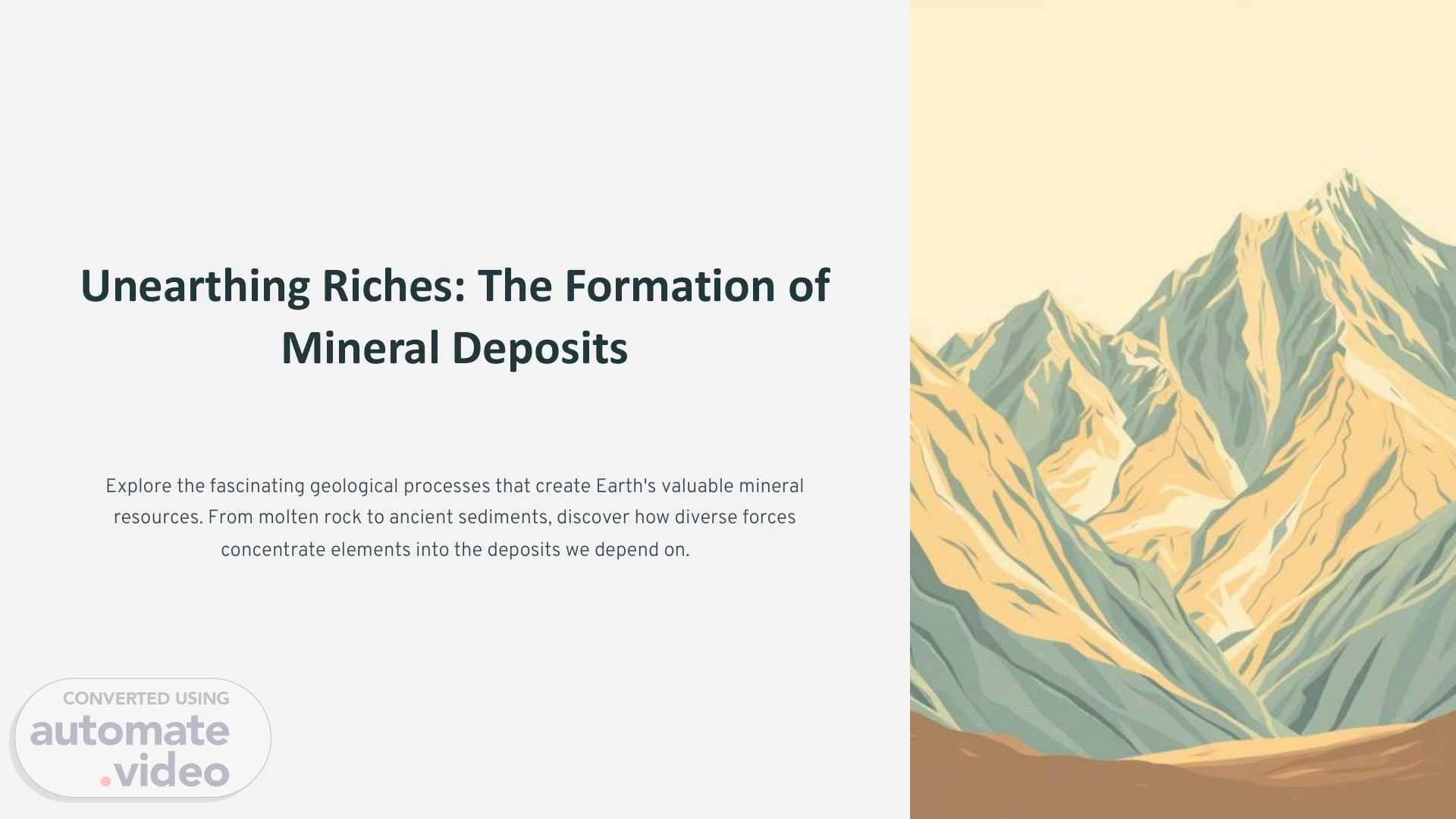
Unearthing-Riches-The-Formation-of-Mineral-Deposits (1).pdf
Scene 1 (0s)
[Audio] Unearthing Riches: The Formation of Mineral Deposits Explore the fascinating geological processes that create Earth's valuable mineral resources. From molten rock to ancient sediments, discover how diverse forces concentrate elements into the deposits we depend on..
Scene 2 (19s)
[Audio] Agenda: A Journey Through Mineral Formation Introduction: Setting the stage for Earth's hidden treasures. Magmatic Processes: Minerals from Earth's fiery depths. Hydrothermal Processes: The power of hot water. Sedimentary Processes: Deposits from ancient waters. Metamorphic Processes: Minerals transformed by heat and pressure. Placer Processes: Concentrates formed by gravity and water. Weathering Processes: Residual deposits. Key Takeaways: Summarizing our geological journey..
Scene 3 (57s)
[Audio] Magmatic Processes: Minerals from Molten Rock Magmatic processes involve the cooling and solidification of molten rock (magma) within or on the Earth's crust. As magma cools, different minerals crystallize at various temperatures, concentrating valuable elements. This can lead to the formation of large, economically significant deposits. Key Examples: Chromite: Often found in layered mafic intrusions (e.g., Bushveld Complex, South Africa). Platinum Group Elements (PGEs): Associated with mafic and ultramafic intrusions (e.g., Noril'sk, Russia). Diamond: Formed in Earth's mantle and brought to the surface by kimberlite and lamproite volcanic pipes..
Scene 4 (1m 47s)
[Audio] Hydrothermal Processes: The Power of Hot Water Fluid Circulation Precipitation Key Deposits Hot, chemically active fluids circulate As these fluids move, they encounter Hydrothermal processes are responsible through rock fractures, dissolving and changes in temperature, pressure, or for a vast array of metal deposits, transporting elements from their source. chemistry. These changes cause the including: These fluids can be magmatic, meteoric dissolved minerals to precipitate, filling Gold & Silver: Found in epithermal and (rainwater), or connate (trapped in veins, fractures, and pores within the host mesothermal veins. sediments). rocks. Copper: Porphyry copper deposits (e.g., Bingham Canyon, USA). Lead & Zinc: Mississippi Valley-type (MVT) deposits. Hydrothermal deposits are among the most common and economically important mineral deposit types, responsible for much of the world's precious and base metal production..
Scene 5 (3m 1s)
[Audio] Sedimentary Processes: Deposits from Ancient Waters Sedimentary mineral deposits form when minerals accumulate in layers, often in bodies of water like oceans or lakes, through physical or chemical precipitation. These processes are typically responsible for large-volume, stratiform deposits..
Scene 6 (3m 23s)
[Audio] Metamorphic Processes: Minerals Transformed Metamorphic processes involve the alteration of existing rocks by heat, pressure, and/or chemically active fluids without melting. This can lead to the recrystallization of existing minerals or the formation of new ones, often concentrating valuable elements. Notable Examples: Graphite: Formed from the metamorphism of carbon-rich sedimentary rocks. Garnet & Corundum: Gem-quality minerals often formed in regional metamorphic terrains. Talc: Produced from the metamorphism of ultramafic rocks. Asbestos: A group of fibrous silicate minerals formed by metamorphism (historical use)..
Scene 7 (4m 12s)
[Audio] Placer Processes: Concentrates by Gravity Erosion & Transport Gravity Separation Key Minerals Weathering and erosion break down primary mineral Due to their higher density, these heavy minerals settle out Gold: Classic placer mineral, often found in alluvial deposits, releasing heavy, durable minerals (like gold or of the water flow more readily than lighter sediments. They deposits. diamonds) from their host rocks. These minerals are then accumulate in specific locations where water current slows, Diamonds: Found in ancient or modern river channels transported by water. such as river bends, sandbars, or beach environments. (e.g., along the Orange River, South Africa). Tin (Cassiterite): Significant placer deposits in Southeast Asia. Platinum: Also found in alluvial placers..
Scene 8 (5m 10s)
[Audio] Weathering Processes: Residual Enrichment Weathering processes involve the chemical or physical breakdown of rocks at or near the Earth's surface. In certain conditions, these processes can leach soluble elements away, leaving behind concentrations of less soluble, valuable minerals. This often results in "residual" deposits. A prime example is the formation of bauxite, the primary ore for aluminum. Bauxite forms in tropical and subtropical regions where intense chemical weathering of aluminum-rich rocks (like feldspar-rich igneous rocks) removes silica and other soluble components, leaving behind a residual concentration of aluminum hydroxides. Other residual deposits include some iron ores and certain clay minerals. These processes highlight how surface interactions can also create economic mineral concentrations, demonstrating the dynamic nature of Earth's crust..
Scene 9 (6m 11s)
[Audio] Summary: A Spectrum of Geological Forces The formation of mineral deposits is a testament to the diverse and powerful geological forces constantly at work within and upon our planet. Each process — magmatic, hydrothermal, sedimentary, metamorphic, placer, and weathering — plays a unique role in concentrating elements into the valuable resources that drive our industries and societies. Magmatic From cooling magma Hydrothermal Hot fluid circulation Sedimentary Accumulation in water Metamorphic Heat & pressure transformation Placer Gravity sorting by water Weathering Surface breakdown and enrichment Understanding these processes is crucial for mineral exploration, resource management, and appreciating the intricate workings of Earth's systems..
Scene 10 (7m 1s)
[Audio] Thank You! We hope this presentation has shed light on the incredible journey of mineral deposit formation. Questions?.